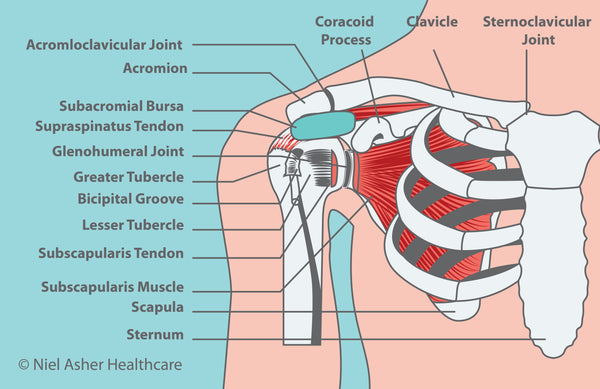Frozen Shoulder and Diabetes
Frozen Shoulder or Impingement?
What is the connection between frozen shoulder and diabetes?
A frozen shoulder seems to result from the way the brain responds to inflammation around the long head of the biceps in the rotator interval.
In some people, and we still don’t know why, the brain over-reacts to this inflammation by switching off groups of muscles and changing their dynamics.
We do know however, that frozen shoulder is much more common in diabetics. About 20% of diabetics are affected compared to around 5% of the general population.
It is not clear why this should be the case but experimental studies have shown that the soft tissues of the shoulder are stiffer than normal.

Collagen
All muscle fibers are ‘packed’ within other tissue called parenchyma. This packing substance is made of collagen. Collagen helps to make up the elastic component of the skin and muscles (ex. as we get older our skin wrinkles as a result of decreased collagen production).
US doctors NA Friedman and MM LaBan published a paper in 1989 in which they put forward two theories as to why frozen shoulder is more common in those suffering with diabetes.
Diabetes and Frozen Shoulder - Theory 1
Because Type I diabetics are unable to regulate their blood sugar levels naturally, there are many times during the day that the sugar levels may be high, which can lead to an accumulation of sugar-alcohol in the tissues.
This sugar-alcohol is called sorbitol and it accumulates in the ‘ground substance’ of the connective tissues (collagen) where, because it has a higher osmotic pressure, it attracts water, making the tissues stiffer.
Diabetes and Frozen Shoulder - Theory 2
An alternative explanation has been put forward, whereby the properties of the collagen itself are attenuated.
It has been suggested that the collagen becomes embedded with excess sugar called glycogen.
This ‘glycosylation’ of collagen leads to more bonds and bridges being formed at a molecular level between collagen molecules, thus changing the internal structure of the collagen.
This means that enzymes cannot efficiently replace normal collagen wear and tear, and the tissues get stiffer.
Treatment
If you suffer with diabetes and begin to experience symptoms of a frozen shoulder, we strongly advise seeking attention as soon as possible. There are manual therapy techniques that are extremely effective for treating this condition, but early intervention can be important.
Whilst surgery is often recommended in severe cases, in our opinion, this should be considered as a last resort only.
Find a Trigger Point Professional in your area
Dry Needling for Trigger Points
Certify as a Trigger Point Therapist
This trigger point therapy blog is intended to be used for information purposes only and is not intended to be used for medical diagnosis or treatment or to substitute for a medical diagnosis and/or treatment rendered or prescribed by a physician or competent healthcare professional. This information is designed as educational material, but should not be taken as a recommendation for treatment of any particular person or patient. Always consult your physician if you think you need treatment or if you feel unwell.
About Niel Asher Education
Niel Asher Education (NAT Global Campus) is a globally recognised provider of high-quality professional learning for hands-on health and movement practitioners. Through an extensive catalogue of expert-led online courses, NAT delivers continuing education for massage therapists, supporting both newly qualified and highly experienced professionals with practical, clinically relevant training designed for real-world practice.
Beyond massage therapy, Niel Asher Education offers comprehensive continuing education for physical therapists, continuing education for athletic trainers, continuing education for chiropractors, and continuing education for rehabilitation professionals working across a wide range of clinical, sports, and wellness environments. Courses span manual therapy, movement, rehabilitation, pain management, integrative therapies, and practitioner self-care, with content presented by respected educators and clinicians from around the world.
Known for its high production values and practitioner-focused approach, Niel Asher Education emphasises clarity, practical application, and professional integrity. Its online learning model allows practitioners to study at their own pace while earning recognised certificates and maintaining ongoing professional development requirements, making continuing education accessible regardless of location or schedule.
Through partnerships with leading educational platforms and organisations worldwide, Niel Asher Education continues to expand access to trusted, high-quality continuing education for massage therapists, continuing education for physical therapists, continuing education for athletic trainers, continuing education for chiropractors, and continuing education for rehabilitation professionals, supporting lifelong learning and professional excellence across the global therapy community.

Continuing Professional Education
Looking for Massage Therapy CEUs, PT and ATC continuing education, chiropractic CE, or advanced manual therapy training? Explore our evidence-based online courses designed for hands-on professionals.



















